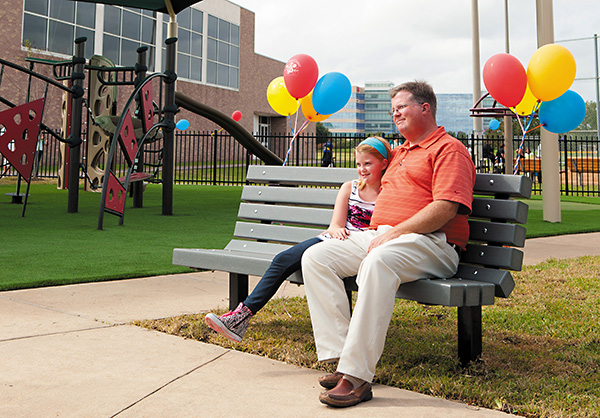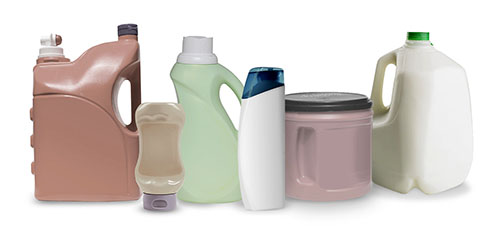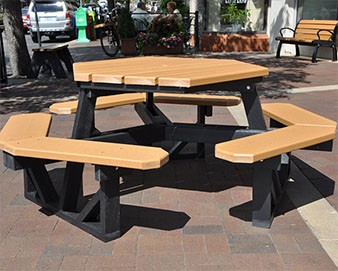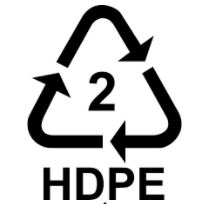 This Earth Day, it's important to educate people about the end result of all that recycling - the manufacturing of recycled benches, pipes, picnic tables and other items
This Earth Day, it's important to educate people about the end result of all that recycling - the manufacturing of recycled benches, pipes, picnic tables and other items
This Earth Day, 2018, when it comes to plastics, there's some great news and there's some bad news.
Let's start with the good news. And that good news concerns plastic products known as HDPE #2 (high-density polyethylene).
HDPE is a heavy-duty plastic used to make milk jugs, detergent bottles, margarine tubs, bottles from household cleaners and cereal box liners to name a few.
 Products made with the stronger HDPE plastic include milk jugs, shampoo bottles and detergent containers. Photo credit: Association of Plastic Recycler
Products made with the stronger HDPE plastic include milk jugs, shampoo bottles and detergent containers. Photo credit: Association of Plastic Recycler
This is a hardy type of plastic that is perfect for manufacturing sturdy, reliable products. Those products that we use every day include recycled benches, recycled picnic tables, pipes, recycled plastic trash cans and recycling bins.
More and more businesses, municipalities and schools are installing recycled benches and recycled picnic tables at their facilities for a number of reasons.
For one, the manufacturing technology has advanced to the point where these recycled products have now become very reliable and long-lasting in harsh environments.
Many recycled plastic benches and recycled picnic tables come with an unheard of 50-year warranty against damage by rot, termites or splintering. That's certainly better than traditional products made with wood.
The plastic planks are also resistant to UV rays which can damage wood fibers. As far as maintenance, there really isn't any effort required. The planks are easy to clean, many times with just soap and water. Graffiti is easy to remove with simple industrials cleaners. These planks never need to be sanded or repainted.
In fact, manufacturers say the demand for these types of recycled products is so high, they can't get enough HDPE plastic scrap to keep up.
Here's the challenge - the Environmental Protection Agency says only about 28% of the HDPE products, such as milk jugs and water bottles that we use, are recycled. That means 72% are wasting away in landfills.
In essence, we are leaving money on the table. We continue to stuff our landfills with this valuable high-grade plastic that is in high demand for recycled benches and recycled picnic tables.
Recycled benches and picnic tables show transformation of trash into products
 Adding recycled picnic tables to schoolyards is an effective way to show students the end result of recycling
Adding recycled picnic tables to schoolyards is an effective way to show students the end result of recycling
How do we fix this?
Here's an interesting quote from Keep America Beautiful: "23% of Americans would recycle more bathroom products if they understood how they are turned into new products."
The challenge for sustainability departments, municipalities, schools and businesses is to purchase these recycled products and then educate the public that this is the result of all those jugs and bottles they place in recycling receptacles.
Educating children on this process is critical. We can literally change the minds of an entire generation when it comes to the value of recycling.
By adding recycled plastic picnic tables to schoolyards, educators can show students this is where your plastic bottles can go and how you can save the planet - if you recycle.
Because here's another piece of good news - recycling efforts have grown in the US to the point where in 2009, about 95% of Americans had access to plastic bottle recycling programs.
 Watch for HDPE symbo
Watch for HDPE symbo
You remember the three arrows in the recycling symbol?
The first arrow represents the Collection process. As we can see, most Americans can now participate in the recycling process, although only about 1 in 3 people actually do recycle their trash.
The second arrow represents the use of the collected plastic to Manufacture items such as recycled benches and recycled picnic tables.
The third arrow promotes the Purchase/Reuse of those recycled products. This is also a crucial component of recycling - to put that scrap back to use at schools, parks, restaurants, public buildings and businesses.
The world continues to be a big consumer of plastic
Now for the bad news.
- The average American produces 4.4 pounds of Trash Per Day.
- But only Recycles or composts 1.5 pounds of that trash.
- Around the world, humans buy a Million Plastic Bottles Per Minute.
- 91% of All Plastic in general, such as plastic bags, is not recycled.
- In 2009, One out of every Ten items picked up in a Coastal Beach Cleanup was a plastic bag.
- By 2050, the ocean will contain More Tons of Plastic than Tons of Fish.
In other words, we are producing, consuming and discarding more plastic than ever.
There's certainly a disconnect here.
There's plenty of plastic out there to be recycled. We have the means to collect this used plastic. And we now have a process to produce high-quality, reliable products from plastic scrap.
All we have to do is step up our game.
We can do it. In 2012, the collection of HDPE bottles rose 45.3 million pounds up to 1 billion pounds for the first time.
"We are very encouraged by the steady growth of plastic bottle recycling," said Steve Alexander, president of the Association of Plastic Recyclers. "Used plastics are valuable materials and recyclers rely on all of us to make sure these resources make it into a recycling bin."
He added: "We know there are increased environmental and economic benefits that come from recycling, but only if the materials recycled are made into new products or goods."
The solution is simple. It just takes three simple steps, just like the arrows in the recycling symbol.
Step one: Warn people about the dangers of continuing to overwhelm our landfills, pollute our oceans and use of our precious resources with plastic bottles.
Step two: Recycle more of those plastic bottles, milk jugs, and detergent containers and educate the public, friends and children about the benefits of doing it as well.
Step three: Buy products made with plastic scrap such as recycled benches and recycled picnic tables to show people real-life examples of the positive effects of their recycling efforts.
It's that easy.
To commemorate this Earth Day, April 22, when it comes to plastic bottles and pollution, let people know a better, safer alternative exists.
There is a process already in place to give new life to our old plastic trash. We just need to follow it.


